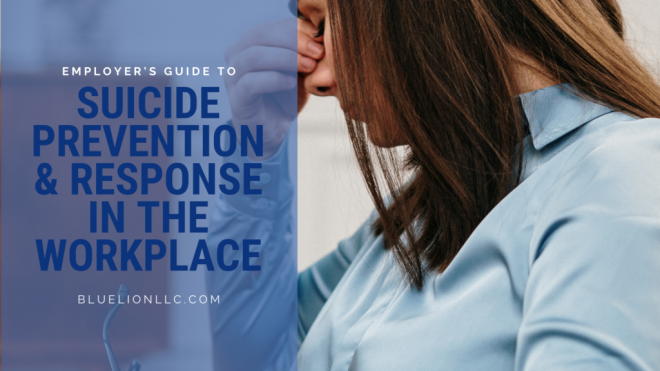
More Americans die by suicide than in car crashes, by homicide, or in other injury-related deaths, according to a 2012 report published in the American Journal of Public Health.
Suicide is more common than many may realize, which is why it is so important that everyone—including employers—continue working to shed light on this topic. We need to break the stigma around mental health issues so that individuals who are struggling with thoughts of self-harm feel more comfortable opening up and seeking help.
If you’re wondering how it can affect you as an employer, the Center for Disease Control and Prevention (CDC) reports that the majority of suicide deaths in the United States are among working-age adults (ages 24 to 64), especially men.
Although suicide can impact any workforce, many business owners are uneducated on how to practice suicide prevention at work or respond to suicide deaths. Fortunately, the conversation of workplace mental health is getting more attention than ever. There are many organizations and resources that employers can use to educate themselves and their teams about the signs of suicide and how to prevent it.
Keep reading to learn:
- Why you should address mental health and suicide prevention in the workplace.
- 6 actions your company can take to prevent suicide.
- How to respond to a suicide death.
Why Address Mental Health & Suicide Prevention?
As a business owner, your employees are your most valuable asset.
Fostering a culture of health and safety is humane and good for the overall health of your business. Ensuring your team is in good mental and physical health can help boost productivity. Part of this is having training and resources in place to help people cope with suicide attempts or deaths in the workplace.
Suicide tragedies can affect the workplace through:
- Decreased productivity and morale.
- Increased healthcare costs due to suicidal behavior and untreated mental illness.
- Lingering feelings of grief, trauma, and guilt for coworkers.
This is why it’s vital for workplace leaders to be educated on this sensitive topic and take action when necessary.
How Employers Can Help Prevent Suicide
Below are six steps employers can take for a comprehensive approach to workplace mental health and suicide prevention. Follow these guidelines to maintain a safe, healthy work environment.
Promote social connectedness and open communication.
Create a work environment that makes all employees feel like they are respected and belong.
The Suicide Prevention Resource Center (SPRC) explains that social support and connection are key to preventing suicide. When individuals have positive and supportive relationships and community connections that they can lean on during difficult times, it can help buffer the effects of risk factors in their lives.
The CDC defines connectedness as “the degree to which a person or group is socially close, interrelated, or shares resources with other persons or groups.”
Connectedness can occur:
- Between individuals (e.g.: friends, neighbors, coworkers).
- Among family members.
- In community organizations (e.g.: schools, faith communities).
- Among groups (e.g.: minority groups) to their cultural traditions and history.
As an employer, get to know your employees and help them build positive connections and relationships. This might include creating programs or directing them to other organizations where they will feel comfortable and safe (e.g.: support groups for LGBT or divorced individuals).
Identify and assist employees who may be at risk for suicide.
People who are dealing with suicidal thoughts and other mental health issues often do not seek help on their own. It’s important to learn how to identify those at risk so you can reach them and help them find the care and support they need.
This strategy might include gatekeeper training, suicide screening, and educating the rest of your team about the warning signs. The SPRC lists various signs and risk factors to identify.
Be alert to problems that increase suicide risk like:
- Prior suicide attempt(s).
- Alcohol and drug abuse.
- Mood and anxiety disorders (e.g.: depression, post-traumatic stress disorder [PTSD]).
- Access to a means to kill oneself.
Signs that someone is at immediate risk for suicide might include:
- Talking about wanting to die or kill oneself.
- Looking for a way to kill oneself, like searching online or obtaining a gun.
- Talking about feeling hopeless or having no reason to live.
Additionally, look out for other behavioral changes/increases that might also be related to a painful event, loss, or change, such as:
- Talking about feeling trapped or in unbearable pain.
- Talking about being a burden to others.
- Increasing the use of alcohol or drugs.
- Acting anxious or agitated; behaving recklessly.
- Sleeping too little or too much.
- Withdrawing or feeling isolated.
- Showing rage or talking about seeking revenge.
- Displaying extreme mood swings.
Train managers and coworkers on their roles in preventing suicide in the workplace.
Many of us spend the majority of our days at work. That is a lot of time with colleagues, giving us ample opportunity to get to know one another.
Both managers and coworkers play important roles in suicide prevention at work. They have the ability to observe fellow employees and notice behavioral changes (e.g.: attitude, energy, and social practices).
To address those at risk in the workplace, managers and coworkers can:
- Observe employees who seem to be struggling.
- Ask how the employee at hand is doing.
- Offer a listening ear, free of judgment.
- Mention changes you have noticed in their behavior and let them know you’re concerned about their emotional well-being.
- Encourage those employees to get help from the human resources (HR) department, Employee Assistance Program (EAP), or another mental health professional. Offer to help them arrange the appointment and transport/go with them.
- Check-in with the person regularly and monitor how they are doing.
Learn more about the roles of managers and coworkers in suicide prevention in these helpful downloads from the SPRC.
Increase help-seeking.
Employers should provide resources to teach workers to recognize when they need support. These might include self-help tools and education about services and resources available to them. Show them that there are other options out there that are effective.
You can also create a work environment that embraces finding support and seeking help by making services more convenient and culturally appropriate. This often means providing different options.
Cultural differences can affect how people respond to problems and their attitudes toward death and suicide. It can also influence how they feel about sharing personal information and getting the help they need. Some individuals may not be open to seeing a mental health provider but may be receptive to speaking with a faith community leader or traditional healer.
Ensure access to effective mental health and suicide treatment.
It’s also important to make sure people have access to those resources. A large part of this is reducing financial, cultural, and logistical barriers to mental health and suicide care.
Share resources like helplines, mobile crisis teams, walk-in crisis clinics, hospital-based psychiatric emergency services, and peer-support programs. Eliminate the shame stigma and let people know these options exist.
If you haven’t already, consider implementing an EAP. This is a voluntary work-based intervention program designed to identify and assist employees in resolving problems that may be adversely affecting their performance at work. Through an EAP, employees can seek counseling to help them build other life skills and resilience.
Learn more about employee assistance programs and what they can offer your company.
Reduce access to means of suicide.
Even in the workplace, there are measures to take to ensure the safety of those at suicidal risk. Safely store medications, firearms, and any other objects that could be used for self-harm. Lock any dangerous substances or other lethal means securely.
If you encounter someone who is at immediate risk of suicide, don’t leave them alone. Either stay with them or make sure they are in a private, safe place with another caring person until you can get help.
How to Manage Suicide Postvention in the Workplace
According to A Manager’s Guide to Suicide Postvention in the Workplace, “postvention is psychological first aid, crisis intervention, and other support offered after a suicide to affected individuals or the workplace as a whole to alleviate possible negative effects of the event.” This could include the suicide death of:
- An employee
- A client
- A vendor
- A family member of an employee
It is important for management to be thoughtful and compassionate when handling the effects of a suicide death. They need to provide support to their workforce during this challenging time. The guide linked above breaks down 10 action steps into three phases:

A Manager’s Guide to Suicide Postvention in the Workplace
Show employees empathy, support, and respect by giving them permission to take care of themselves. Listen to their needs, which may vary from one employee to the next. Consider a structured group session for coping and support; it may also be helpful to have counseling staff on hand during these sessions.
Managers also need to monitor employee behavior following a suicide tragedy. This could be verbal, or it could show up as a string of absences—or, the opposite, as an employee who is working too much. With the proper level of support, workplace behavior and accountability can usually be maintained.
Finally, managers should offer help and support to surviving family members (in line with HR policies) with practical matters. This will encourage the rest of the team to reach out to the family to help.
For more assistance and training on handling the delicate situation of suicide prevention and death, contact BlueLion at 603-818-4131 or info@bluelionllc.com. Our HR experts will educate you and your team on mental health in the workplace and how you can look out for your employees.
The information on this website, including its newsletters, is not, nor is it intended to be legal advice. You should contact an attorney or HR specialist for advice on your individual situation.


